Context:
Recently, researchers have developed a unique method for delivering tuberculosis (TB) medicines directly to the brain, addressing the significant challenge posed by the blood-brain barrier (BBB) that limits the effectiveness of many brain TB medicines.
More on the News
- This innovative approach promises to enhance the treatment of Central Nervous System Tuberculosis (CNS-TB), a life-threatening condition with high mortality rate.
- Early lab tests show promising results, with the method potentially reducing bacterial counts in infected brains by nearly 1,000 times.
About the New Method of Drug Delivery
- Scientists at the Institute of Nano Science and Technology (INST), Mohali, an autonomous institute of the Department of Science and Technology (DST) developed tiny particles (nanoparticles) made tiny clusters of nanoparticles made from chitosan, called chitosan nano-aggregates, to deliver TB medicines directly to the brain.
- This method allows the medicines to reach the brain through the nose, effectively bypassing the blood-brain barrier (BBB).
- The innovative nose-to-brain (N2B) drug delivery technique utilizes the olfactory and trigeminal nerve pathways in the nasal cavity to bypass the BBB.
- By delivering the drug through the nasal route, the nano-aggregates can transport the drugs directly into the brain, significantly improving drug bioavailability at the infection site.

Chitosan Nano-Aggregates
- Chitosan is a biocompatible and biodegradable material known for its mucoadhesive properties and sticks to the nasal mucosa, which helps the nano-aggregates stay in place and prolongs the time they can release the drug, enhancing its therapeutic effectiveness.
The chitosan nano-aggregates can hold TB drugs like isoniazid (INH) and rifampicin (RIF).
- Both INH and RIF are antibiotics used to treat tuberculosis (TB). Isoniazid targets the bacteria by inhibiting cell wall synthesis, while Rifampicin works by blocking RNA synthesis, effectively killing the TB bacteria.
This prolongs drug release and enhances therapeutic effectiveness, providing a more targeted treatment for CNS-TB.
Significance of the new Method
- This study is the first to show that nasal delivery of TB drugs using advanced particles can effectively treat brain TB.
- The treatment ensures drug delivery to the brain and reduces infection-related inflammation.
- This approach could also be used for brain infections, neurodegenerative diseases, brain tumours, and epilepsy by enhancing drug delivery to the brain.
About Tuberculosis (TB)
- TB is an airborne bacterial infection disease caused by a bacterium called Mycobacterium tuberculosis.
- TB bacteria primarily affects the lungs, However, it can also attack other parts of the body, including the kidneys, spine, and brain.
Types of TB conditions:
- Pulmonary TB: TB that involves the lungs. It’s likely what most people think of when they hear tuberculosis.
- Extrapulmonary TB: TB that involves parts of the body outside of the lungs, such as the bones or organs (Kidney, spine, brain and lymph nodes). Symptoms depend on the part of the body affected.
Central Nervous System Tuberculosis (CNS-TB)
Tuberculosis (TB) that affects the brain and spinal cord, called Central Nervous System Tuberculosis (CNS-TB), is one of the most dangerous forms of TB, often leading to severe complications or death.
A major challenge in treating CNS-TB is that TB drugs struggle to reach the brain and often fail to achieve effective concentrations in the cerebrospinal fluid due to a protective barrier known as the blood-brain barrier (BBB).
- BBB is a selective, semi-permeable membrane that protects the brain and central nervous system (CNS) from harmful substances and regulates the movement of molecules and ions between the blood and brain.
- It prevents harmful substances (like toxins, pathogens, and certain drugs) from entering the brain while allowing essential nutrients and gases to pass through.
This limitation underscored the need for more effective delivery methods that can target the brain directly.

